The ocean is home to countless mesmerizing creatures that amaze us. From the fascinating Dumbo octopus with its big ears to the graceful peacock mantis shrimp with its powerful punch, these cool sea creatures are a testament to the wonders of marine life.
Join us as we discover some of the most amazing ocean animals and discover their extraordinary features and behaviors. Get ready to be captivated by the beauty and uniqueness of these incredible creatures.
Cool Sea Creatures to Know
1. Blue Whale
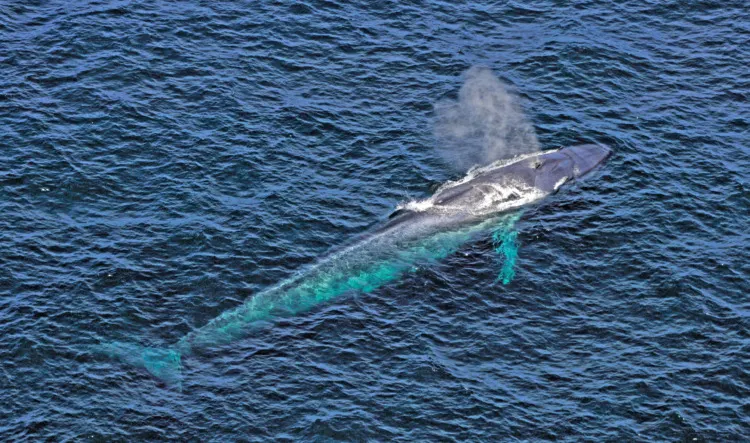
Largest creature on Earth
The blue whale holds the title for being the largest creature on Earth, both in terms of length and weight. These magnificent creatures can reach lengths of up to 98 feet and weigh as much as 200 tons. To put that into perspective, their tongues alone can weigh as much as an elephant!
Blue whales are remarkable in that they are the largest animal to have ever existed on our planet. Despite their enormous size, they are gentle giants, feeding primarily on small shrimp-like creatures called krill. A blue whale is estimated to consume up to 4 tons of krill in a single day!
In addition to their enormous size, blue whales have other unique characteristics. They have a heart the size of a small car, and their vocalizations can be heard for hundreds of miles underwater. These vocalizations play a crucial role in communication and finding mates.
The large size of blue whales is thought to be an adaptation to their oceanic lifestyle, allowing them to efficiently filter-feed on large amounts of krill. Despite their immense size, they are graceful swimmers and can reach up to 20 miles per hour.
The presence of blue whales in our oceans is not only awe-inspiring but also crucial to the health and balance of marine ecosystems. Protecting these incredible creatures is vital for the well-being of our oceans and the entire planet.
Physical characteristics and behavior
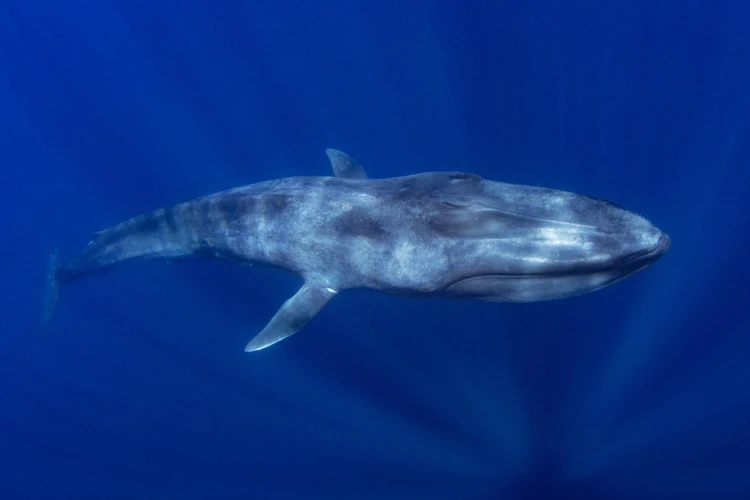
Sharks are known for their distinctive physical characteristics and behavior in the ocean. As apex predators, they have streamlined bodies and powerful tails, allowing swift and agile movements. Their sharp, serrated teeth are designed for tearing through flesh, making them efficient hunters.
Sharks have a keen sense of smell and can detect tiny traces of blood in the water from miles away. They also have a series of specialized senses, including electroreception, which allows them to detect the weak electrical fields emitted by their prey.
In terms of behavior, sharks are known for their solitary nature and are often seen patrolling their territories in search of food. Some species, such as the great white shark, are known to breach the water’s surface when attacking prey, displaying impressive acrobatic abilities.
Contrary to popular belief, sharks are not mindless killing machines. They play a crucial role in maintaining the balance of marine ecosystems as top predators. Sharks also exhibit complex social behaviors, such as courtship rituals and cooperative feeding.
Overall, sharks’ physical characteristics and behavior make them fascinating and formidable creatures in the ocean.
See Related: Fun, Interesting Facts About Whales
2. Great White Shark
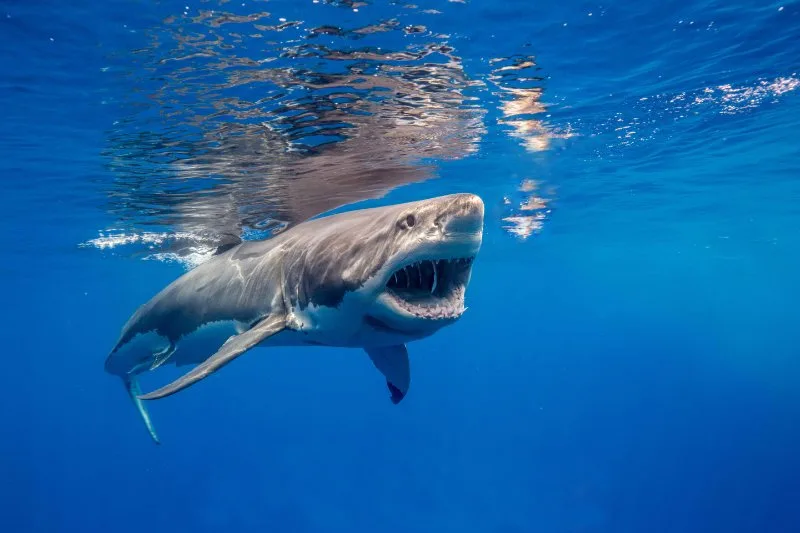
Apex predator of the ocean
The ocean is home to a wide variety of fascinating creatures, and among them are the apex predators that rule the marine ecosystem. These predators hold the top position in the food chain and play a crucial role in maintaining the balance of the oceanic ecosystem. One such apex predator is the shark.
Sharks have existed for millions of years and evolved into efficient killing machines. With their sharp teeth, powerful jaws, and incredible speed, they are perfectly adapted for hunting and capturing prey. Another apex predator is the killer whale, also known as the orca.
Orcas are highly intelligent and social creatures, known for their complex social structures and cooperative hunting techniques. They are formidable predators, capable of taking down large marine mammals, such as seals and even other whales. The apex predators of the ocean are impressive hunters and essential for the health and stability of marine ecosystems.
Adaptations for hunting and survival
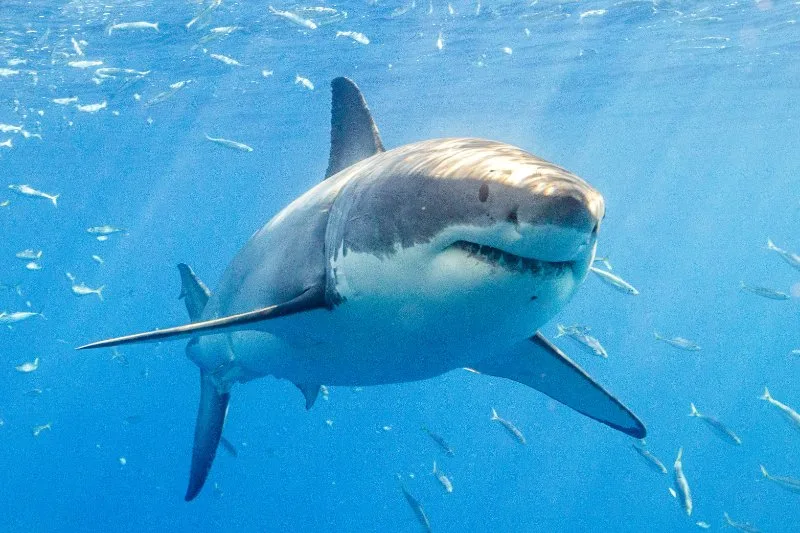
Sea creatures have evolved various adaptations for hunting and survival in their underwater environment. These adaptations are crucial for finding prey, avoiding predators, and thriving in their habitats.
Some common adaptations for hunting and survival in sea creatures include:
- Camouflage: Many sea creatures can blend in with their surroundings, using colors and patterns on their bodies to avoid detection by predators or potential prey.
- Speed and agility: Some sea creatures, such as dolphins and swordfish, have streamlined bodies and powerful muscles that allow them to swim quickly and maneuver through the water precisely, enabling them to catch fast-moving prey.
- Bioluminescence: Some deep-sea creatures can produce light through a process called bioluminescence. This helps them attract prey or deter predators in the ocean’s dark depths.
- Venomous stingers or tentacles: Animals like jellyfish and cone snails have evolved venomous stingers or tentacles to immobilize their prey or defend themselves against predators.
- Suction feeding: Many sea creatures, such as whales and filter-feeding fish, have specialized feeding mechanisms that allow them to filter small prey particles from the water. This adaptation enables them to consume large amounts of food efficiently.
These adaptations and many others allow sea creatures to thrive in their aquatic habitats, contributing to the incredible diversity and beauty of the underwater world.
See Related: How Do Sharks Help The Ecosystem?
3. Giant Pacific Octopus
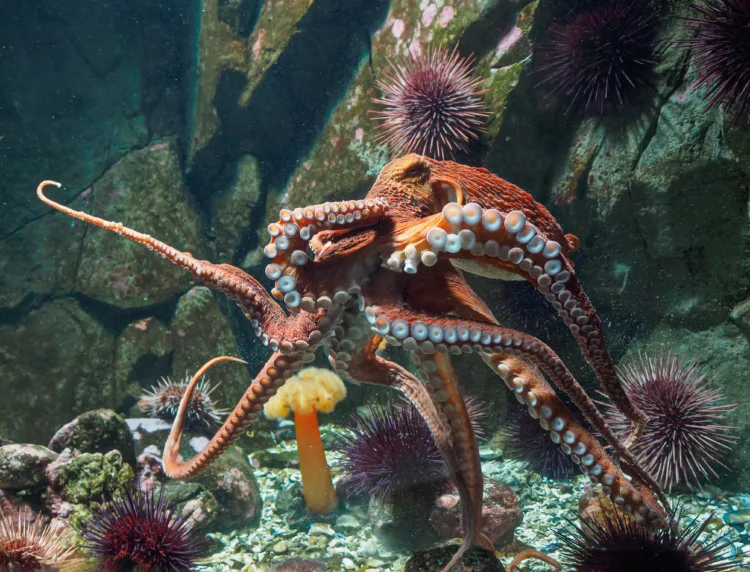
Masters of disguise and intelligence
Masters of disguise and intelligence, sea creatures have evolved various strategies to blend into their surroundings and outsmart predators. One example is the mimic octopus, which can change its color, shape, and behavior to imitate other animals, such as sea snakes, lionfish, and flatfish. This remarkable ability helps it to evade predators and ambush prey.
Another intelligent sea creature is the cuttlefish, known for its ability to camouflage itself with incredible precision. It can rapidly change its skin’s color, texture, and pattern to blend into its environment, making it almost invisible to predators and prey. Cuttlefish also have exceptional problem-solving skills and can learn and remember complex mazes and tasks.
Yet another example is the mantis shrimp, known for its powerful claws and complex visual system. With eyes with 12-16 color-receptive cones (compared to humans’ three), it has unparalleled color vision, which it uses for communication, hunting, and navigating its environment.
Here are some key characteristics of these masterful sea creatures:
- Ability to change color, texture, and behavior for camouflage
- Exceptional problem-solving skills
- Advanced visual systems for hunting and navigation
- Adaptability to various environments in the ocean
These intelligent creatures demonstrate the wonders of the ocean ecosystem and the incredible capabilities of marine life.
See Related: These Are 13 of the Longest Living Animals on Earth
Unique behaviors and abilities
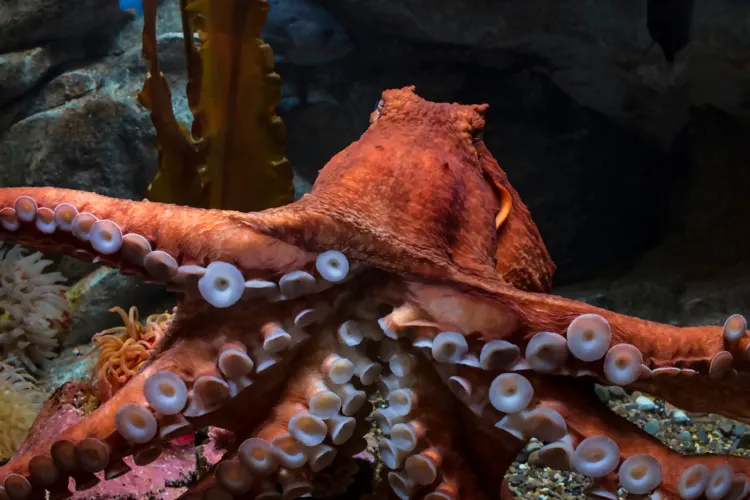
Sea creatures are known for their unique behaviors and incredible abilities that set them apart from other animals. From intelligent problem-solving to impressive displays of strength, these creatures have evolved to survive and thrive in their marine environments. Some notable examples include:
- Octopuses: Octopuses are known for their remarkable intelligence and problem-solving skills. They have been observed using tools, opening jars, and escaping from highly secure enclosures. Their ability to camouflage themselves by changing the color and texture of their skin also makes them masters of deception.
- Manta Rays: Manta rays are known for their graceful swimming capabilities and impressive acrobatic displays. They can leap out of the water, perform somersaults, and glide through the ocean effortlessly. Manta rays also exhibit cooperative feeding behaviors, gathering in large groups to feed on plankton-rich areas.
- Humpback Whales: Humpback whales are known for their complex, melodic songs, which they use for communication and mating. These songs can last for hours and are unique to individual whales. Humpback whales also display remarkable acrobatics, such as breaching and slapping their fins on the water’s surface.
- Cuttlefish: Cuttlefish are masters of disguise, capable of rapidly changing their skin patterns and colors to blend in with their surroundings. They use these abilities for camouflage and communication, displaying intricate color patterns during courtship and aggression.
- Sea Lions: They are highly agile and social marine mammals known for their acrobatic swimming and diving abilities. They can reach up to 25 miles per hour and dive to great depths for food. Sea lions are also excellent communicators, using various vocalizations and body postures to convey different messages.
These unique behaviors and abilities make sea creatures fascinating to observe and highlight marine life’s incredible diversity and complexity.
See Related: What Lives In The Deepest Part of the Ocean? Incredible Mariana Trench Animals
4. Manta Ray
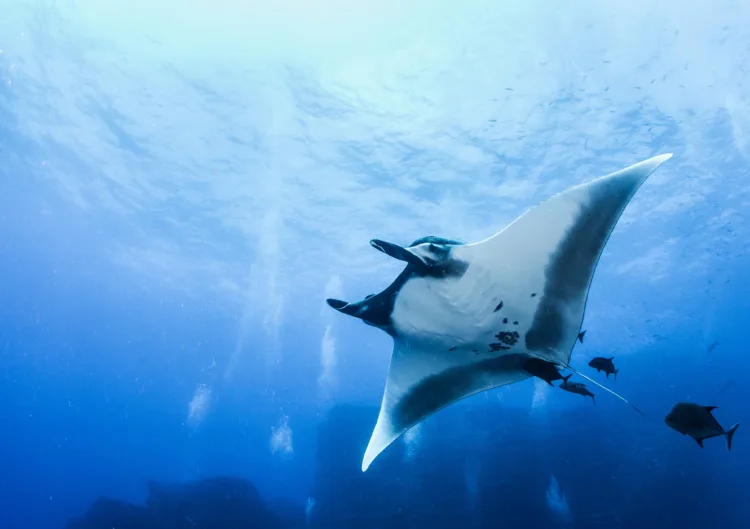
Graceful and gentle giants of the sea
Graceful and gentle giants of the sea are some of the most fascinating creatures inhabiting our oceans. These majestic creatures, such as the humpback whale, the manta ray, and the whale shark, capture our imagination with their size and beauty.
Humpback whales are known for their acrobatic displays, frequently leaping out of the water and slapping the surface with their tails. They have distinctive long pectoral fins measuring up to 15 feet, which they use to maneuver and communicate with other whales.
Manta rays are graceful swimmers that glide effortlessly through the water. They have a unique diamond-shaped body and can reach sizes of up to 23 feet in a wingspan. Manta rays are filter feeders, consuming large quantities of plankton and small fish to sustain their energy needs.
Whale sharks, the largest fish in the ocean, can grow up to lengths of 40 feet or more. Despite their size, they are gentle giants that feed primarily on plankton and small fish by filter feeding. They have a docile nature and are often curious about humans, making them a popular attraction for divers and snorkelers.
These gentle giants play a crucial role in maintaining the balance of our ocean ecosystems. They contribute to nutrient cycling and control smaller marine organisms’ populations, ensuring our oceans’ health and sustainability.
Ecological importance and feeding habits
Ecological importance and feeding habits play a crucial role in the survival and balance of the marine ecosystem. Sea creatures have diverse feeding habits that contribute to the delicate food web in the ocean.
Some sea creatures, such as whales and sharks, are apex predators, feeding on smaller fish and marine mammals, helping to control population sizes and maintaining the balance of the ecosystem. They play a vital role in regulating the food chain and preventing the overgrowth of certain species.
Other sea creatures, like plankton, are at the base of the food chain. They are microscopic organisms that provide food for larger creatures like fish and whales. Plankton are responsible for producing a significant portion of the Earth’s oxygen, making them essential for maintaining oxygen levels and supporting life in the ocean.
Filter feeders, such as manta rays and baleen whales, consume enormous amounts of tiny organisms, called zooplankton, by filtering them from the water. This feeding strategy helps prevent the overpopulation of these microscopic organisms and maintains the ecosystem’s overall health.
Bottom-dwelling creatures, such as crabs and lobsters, play an important role in the marine ecosystem by scavenging and consuming decaying organic matter. They help clean the seafloor and recycle nutrients, maintaining a healthy environment for other species.
Here are some key points about the ecological importance and feeding habits of sea creatures:
- Apex predators like sharks and whales help regulate the food chain.
- Plankton are the basis of the marine food chain and produce significant oxygen.
- Filter feeders consume large amounts of tiny organisms to maintain the balance in population sizes.
- Bottom-dwelling creatures help clean the seafloor and recycle nutrients.
- The feeding habits of sea creatures contribute to the overall health and functioning of the ocean ecosystem.
5. Sea Horse
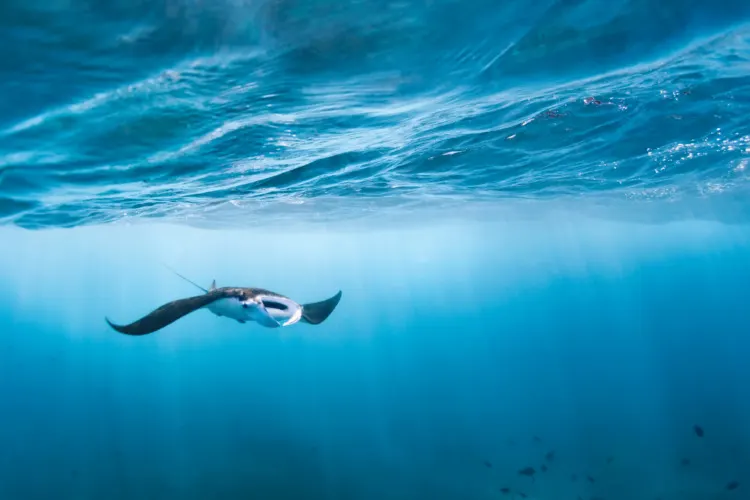
Fascinating mating behaviors
The world of sea creatures is filled with fascinating mating behaviors that are both unique and extraordinary. From elaborate courtship displays to strange mating rituals, these behaviors demonstrate the lengths that sea creatures will go to ensure successful reproduction.
One example of fascinating mating behavior is the courtship dance performed by the mandarinfish. This colorful fish is known for its intricate mating ritual, where the male performs an elaborate dance to attract a female.
The male will display his vibrant colors and fin movements, showcasing his strength and fitness as a potential mate. If the female is impressed by the display, she will signal her interest by joining in the dance, and the pair will engage in a complex spawning process.
Another example is the mating behavior of the blanket octopus. In this species, the male is significantly smaller than the female and has a modified third arm that acts as a reproductive organ.
When ready to mate, the male will detach this arm and transfer it to the female, who will keep it until she lays her eggs. This behavior ensures successful fertilization and allows the female to control when and where she releases her eggs.
Here are some fascinating mating behaviors among sea creatures:
- The elaborate courtship display of the mandarinfish
- The male seahorse’s role in pregnancy and birth
- The unique mating dance of cuttlefish, which involves changing colors and patterns
- The synchronized spawning of coral reefs
- The territorial fights of male anglerfish, where they fuse with females after mating
These behaviors highlight the incredible diversity and complexity of mating rituals in the ocean and provide insight into the fascinating world of sea creatures
See Related: Most Beautiful & Majestic Animals in the World
Uniqueness in the animal kingdom
Regarding uniqueness in the animal kingdom, sea creatures have their fair share of fascinating features and characteristics that set them apart from other animals. From their intricate adaptations to their unconventional behaviors, here are some examples of the uniqueness displayed by sea creatures:
- Mimicry and camouflage: Many sea creatures have evolved remarkable abilities to blend in with their surroundings or imitate other organisms as a defense mechanism. The mimic octopus, for instance, can change its shape, color, and behavior to imitate various marine animals, such as poisonous lionfish or venomous sea snakes.
- Bioluminescence: Some marine organisms, particularly deep-sea dwellers, can produce light through a biochemical process called bioluminescence. This unique adaptation serves a variety of purposes, including communication, attracting prey, and camouflaging in the depths of the ocean.
- Extraordinary reproductive strategies: Sea creatures exhibit a wide array of reproductive strategies that are highly specialized and often unique. For example, the anglerfish species features extreme sexual dimorphism, where the male is much smaller than the female and permanently fuses to her body, acting as a parasitic mate.
- Extreme size and longevity: The ocean is home to some of the largest and longest-lived creatures on Earth. For instance, the blue whale holds the title for being the largest animal ever to exist, growing up to 100 feet in length. Additionally, some species of sea turtles can live for over 100 years.
- Sensory adaptations: Sea creatures have evolved various sensory adaptations to thrive in their underwater environments. Some fishes have unique electroreceptive organs called ampullae of Lorenzini, which allow them to detect electrical signals emitted by prey or other animals. Sharks are especially known for their keen sense of smell; some can detect a drop of blood from miles away.
As we explore the depths of the oceans, we continue to uncover more fascinating examples of sea creatures’ unique characteristics and behaviors. These incredible adaptations and traits contribute to the ocean ecosystem’s biodiversity and showcase the wonders of the animal kingdom.
6. Anglerfish
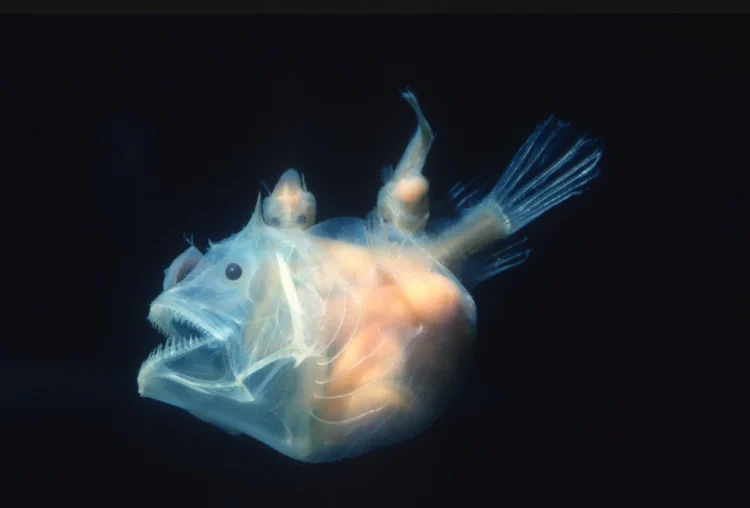
Bizarre appearance and hunting strategy
One of the most fascinating aspects of sea creatures is their bizarre appearance and unique hunting strategies. From unusual physical features to creative techniques, these creatures have become truly remarkable.
For example, the anglerfish has a large mouth and sharp teeth, but what sets it apart is the bioluminescent lure that dangles from its head. This lure, combined with its ability to camouflage, attracts prey in the ocean’s dark depths.
Another intriguing creature is the mantis shrimp. With its vibrant colors and intricate patterns, it is known for having the fastest punch in the animal kingdom. Its appendages can move at an astonishing speed, striking its prey with incredible force.
With its ability to change colors and textures, the cuttlefish is a master of disguise. It can mimic its surroundings, blending seamlessly into its environment. This camouflage helps it both hide from predators and ambush its unsuspecting prey.
The vampire squid is another strange-looking creature that inhabits the deep sea. Despite its name, it feeds on detritus and small prey rather than blood. It has large, webbed tentacles covered in small, light-producing photophores that create a stunning display to confuse its predators.
These examples highlight just a few of the many bizarre and fascinating sea creatures found in our oceans. Their appearance and hunting strategies showcase marine life’s incredible diversity and adaptability.
Deep-sea dwellers with specialized adaptations
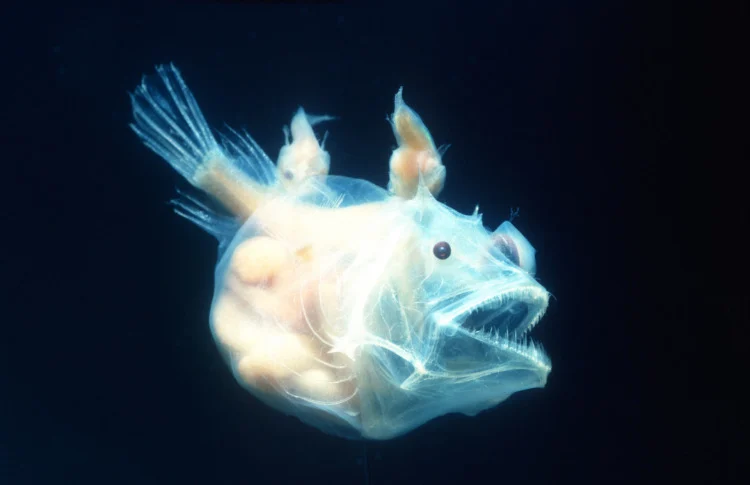
Deep-sea dwellers are fascinating creatures with specialized adaptations that allow them to survive in the extreme conditions of the deep ocean. These creatures have evolved unique features that enable them to thrive in the deep sea’s darkness, cold temperatures, high pressure, and low oxygen levels.
One example of a deep-sea dweller with specialized adaptations is the anglerfish. The anglerfish has a bioluminescent lure on its head that attracts prey in the ocean’s dark depths. Its oversized mouth allows it to swallow large prey easily, and its expandable stomach enables it to consume meals that are larger than its body size.
Another example is the giant tube worm. These worms live near hydrothermal vents on the ocean floor and rely on chemosynthesis rather than photosynthesis for energy. They have a symbiotic relationship with bacteria that live inside their bodies and convert chemicals from the vents into usable energy.
Deep-sea creatures like the vampire squid have developed unique strategies for defense. The vampire squid can turn itself inside out, exposing rows of spines and bioluminescent organs to scare away predators.
The deep sea is also home to creatures with extraordinary abilities, such as the lanternfish, which has photophores along its body that emit bioluminescent light. This light helps the lanternfish blend in with its surroundings and can also be used to attract prey or confuse predators.
Deep-sea dwellers have adapted to their harsh environment through specialized features, behaviors, and abilities. These adaptations allow them to survive and thrive in one of Earth’s most extreme habitats.
See Related: Is a Fish an Animal? Here’s What You Need to Know
7. Lion’s Mane Jellyfish
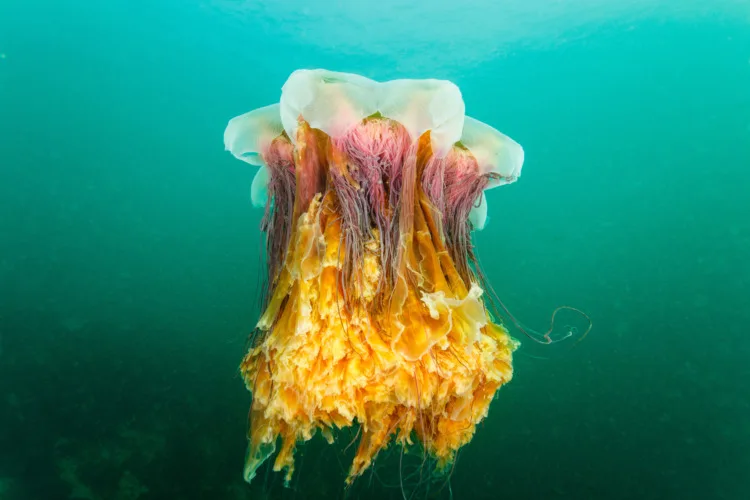
Largest known jellyfish species
One of the most fascinating sea creatures is the Lion’s Mane Jellyfish (Cyanea capillata), known as the world’s largest jellyfish species. This magnificent creature can have a bell diameter of up to 8 feet and its tentacles can stretch up to 120 feet long. It is commonly found in the cold waters of the Arctic and the northern regions of the Pacific and Atlantic Oceans.
The Lion’s Mane Jellyfish is known for its distinctive appearance, with its bell resembling a lion’s mane, hence its name. Its tentacles are covered in thousands of tiny stinging cells called nematocysts, which it uses for capturing prey and defending itself against predators.
The stinging capabilities of the Lion’s Mane Jellyfish can cause mild irritation or, in rare cases, more serious symptoms in humans. It primarily feeds on small fish, plankton, and other jellyfish. Its diet helps maintain the marine ecosystem’s balance by controlling the populations of other species.
Despite its impressive size, the Lion’s Mane Jellyfish is a delicate creature and can be easily damaged by human activity, such as pollution and climate change. Understanding and protecting these unique creatures is crucial for the health and preservation of our oceans.
Stinging capabilities and impact on marine ecosystems
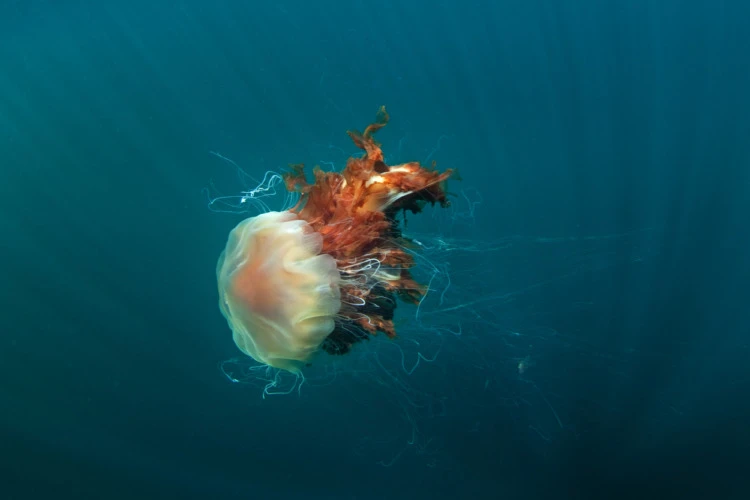
Jellyfish, one of the most fascinating sea creatures, are known for their stinging capabilities and their impact on marine ecosystems. These gelatinous animals have tentacles lined with stinging cells called nematocysts, which they use for defense and capturing prey. When a jellyfish comes into contact with another organism, the nematocysts inject venom into the victim, causing a painful sting.
The impact of jellyfish stings on marine ecosystems can be significant. They can disrupt the balance of marine ecosystems by outcompeting other organisms for food and resources.
Their voracious appetite for zooplankton and small fish can reduce these species’ populations, affecting the entire food chain. Additionally, jellyfish blooms, which are large aggregations of jellyfish, can lead to oxygen depletion in the water due to their high metabolic rates and waste production, further impacting marine life.
However, it is important to note that not all jellyfish species hurt marine ecosystems. Some species are an essential part of the marine food web and contribute to the overall health and diversity of the ecosystem.
Here’s a list of key points regarding the stinging capabilities and impact of jellyfish on marine ecosystems:
- Jellyfish have tentacles lined with stinging cells called nematocysts.
- The venom injected by jellyfish stings can cause pain and discomfort in humans.
- Jellyfish can disrupt marine ecosystems by outcompeting other organisms for resources.
- Their voracious appetite for prey can lead to reduced zooplankton and small fish populations.
- Jellyfish blooms can result in oxygen depletion in the water, affecting marine life.
- However, some jellyfish species play a vital role in the marine food web and contribute to ecosystem health.
- Studying jellyfish and understanding their impact on marine ecosystems is crucial for conservation efforts.
The diversity and beauty of sea creatures
The ocean is home to many diverse and beautiful creatures that amaze us. From the vibrant colors of tropical fish to the graceful movements of whales, the underwater world is a treasure trove of awe-inspiring species.
Sea creatures, from tiny plankton to massive whales, come in all shapes and sizes. They inhabit every ocean corner, from shallow coastal waters to deep-sea trenches. Each species has unique adaptations and characteristics that allow it to thrive in its specific environment.
One of the most fascinating aspects of sea creatures is their incredible diversity. There are over one million known species of marine life, and scientists estimate that there may be millions more yet to be discovered. From delicate sea anemones to bizarre deep-sea creatures with bioluminescent abilities, each species adds to the breathtaking beauty of the underwater world.
The ocean ecosystem is a delicate balance, and sea creatures play a vital role in maintaining health. From providing food for other species to helping regulate the Earth’s climate, these creatures are integral to the overall functioning of our planet. It’s important that we take measures to protect their habitats and ensure their survival for future generations to appreciate and enjoy.
Interesting facts about the ocean ecosystem
The ocean ecosystem is a fascinating and diverse environment that is home to a wide variety of unique and interesting creatures. Here are some interesting facts about the ocean ecosystem:
- Biodiversity: The ocean is the largest ecosystem on Earth, covering over 70% of the planet’s surface and containing an estimated 50-80% of all life on Earth.
- Habitat Variety: The ocean comprises different zones, including the intertidal zone, the pelagic zone (open ocean), and the benthic zone (ocean floor), each with its own distinct set of organisms.
- Food Chain: The ocean’s food chain is complex and interconnected, with small phytoplankton at the bottom, followed by zooplankton, small fish, larger predators, and apex predators like sharks and whales.
- Coral Reefs: Coral reefs are some of the most diverse and vibrant ecosystems in the ocean, providing a home for countless species of fish, plants, and invertebrates.
- Deep Sea: The deep sea begins at depths of around 200 meters (656 feet) and is a mysterious and largely unexplored part of the ocean. It is home to fascinating and unusual creatures adapted to survive in extreme conditions, such as bioluminescent fish and giant tube worms.
- Migration: Many ocean creatures undertake long-distance migrations, such as sea turtles and whales, traveling thousands of miles between feeding and breeding grounds.
- Carbon Storage: The ocean plays a crucial role in regulating the Earth’s climate by absorbing and storing large amounts of carbon dioxide, helping mitigate climate change’s impacts.
- Threats: Human activities, such as overfishing, pollution, and climate change, pose significant threats to the health and biodiversity of the ocean ecosystem.
By understanding the importance and uniqueness of the ocean ecosystem, we can work towards better conservation and management to protect these incredible creatures.
Related Resources
- These Animals Have the Best Hearing in the World
- Different Animals That Can’t Jump
- These Are the Strongest Animals in the World


